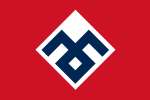National Popular Rally
This article includes a list of general references, but it lacks sufficient corresponding inline citations. (March 2020) |
National Popular Rally Rassemblement national populaire | |
|---|---|
French fascism
red, white | |
| Party flag | |
 | |
The National Popular Rally (French: Rassemblement national populaire, RNP, 1941–1944) was a French political party and one of the main collaborationist parties under the Vichy regime of World War II.
Created in February 1941 by former members of the
February–October 1941: the RNP-MNR period
Immediately, the
However, the fusion between the RNP and the MSR was a failure, in part because Déat's RNP recruited mainly among former members of the French Left while the MSR was from the beginning located on the far-right of the political spectrum. The MSR conserved de facto its autonomy inside the RNP and was mainly charged of forming the RNP's security service. After the assassination attempt of Paul Collette against Pierre Laval, Marshal Philippe Pétain's Prime Minister and Marcel Déat on 27 August 1941, the latter accused the MSR of having attempted to eliminate him. Thereafter, the MSR was excluded from the RNP in October 1941, leading to the reorganization of the RNP (and exclusion of elements close to the MSR) until the first months of 1942.
The RNP without the MSR (after October 1941)
The ideology of the RNP was clearly of a
On a tactic level, the RNP supported Pierre Laval and criticized the "Vichy reactionaries" and the PPF. Marcel Déat maintained close links with the German ambassador in Paris,
In March 1944, Déat was named Minister of Labour and of National Solidarity and took as assistants the RNP leaders (Georges Albertini, Georges Dumoulin, Ludovic Zoretti and Gabriel Lafaye) From then on, he focused more on his ministry tasks than on the organization of the RNP.
On 17 August 1944, Déat took refuge in Nazi Germany almost alone. In charge of the youth organisation of the RNP, Roland Gaucher would also accompany Pétain into exile in the Sigmaringen enclave.
Organisation of the RNP following October 1941
The RNP had at maximum 30,000 members.[4] According to the historian Robert Soucy, it had only 2,638 party members, of whom only 12.8 percent were industrial workers.[5]
Its mouthpiece, directed by Roland Gaucher, was Le National Populaire, but the party was also supported by Déat's daily, L'Œuvre.
The youth organisation (
Primary members of the RNP (after October 1941)

The RNP was directed by a permanent commission of 15 members. According to a February 1943 list, these included:
- Président: Marcel Déat
- General secretary: Est-Ouestmagazine)
- Vice president (from January 1943): Maurice Levillain (neosocialist)
- Vice président (from January 1943): Michel Brille (former deputy of the Democratic Alliance)
- Henri Barbé (former member of the French Communist Party's political bureau, excluded in 1934 and general secretary of the PPF from 1936 to 1939)
- René Benedetti (neosocialist)
- Francis Desphilippon
- Georges Dumoulin
- Emile Favier (neosocialist)
- Jacques Guionnet
- Gabriel Lafaye (neosocialist, state secretary in Camille Chautemps's government in 1938)
- Barthélémy Montagnon (former SFIO deputy, expelled in 1933, then neosocialist)
- Georges Rivollet (former Minister of War Veterans in right-wing governments of 1934–1935)
- Roland Silly (former member of the SFIO)
- Ludovic Zoretti (trade unionist)
Expelled personalities
- Jean Goy (conservative) and Charles Spinasse (Minister of the Popular Front), both expelled in 1942 on charges of being too moderate
- Radical-Socialist) expelled in 1943
Other RNP personalities
- National Front)[7]
- Pierre Célor
- Roland Gaucher (1919–2007), in charge of the RNP's youth organisation[8] and of the RNP Parisian section from May to November 1943[9] as well as future founder of the National Front in 1972
- André Grisoni
- Fernand Hamard
- Henri Jacob
- Paul Perrin
- Pierre Vigne, trade union leader
See also
- French Popular Party – associated with former French Communist Party members
Sources
- Pierre-Philippe Lambert and Le Marec. Organisation Mouvements et unités de l'État français Vichy 1940-1944. Paris. Éditions Grancher. 1992.
- Pascal Ory. Les Collaborateurs 1940-1945. Paris: Le Seuil. 1976.
- Reinhold Brender. Marcel Déat und das Rassemblement National Populaire, Ed. Oldenbourg. Munich. 1992.
References
- ^ Les Collaborateurs. Le Seuil. 1976. p. 331.
- ^ Dominique Venner (2007). Histoire de la Collaboration. Pygmalion. p. 578.
- ^ Pascal Ory. Les collaborateurs.
- ^ Le Marec-Lambert.
- New York Review of Books. Volume 43. Number 13. 8 August 1996 (in English).
- ^ "Archived copy". www2.cndp.fr. Archived from the original on 20 July 2011. Retrieved 6 June 2022.
{{cite web}}: CS1 maint: archived copy as title (link) - Sciences-Po(p. 4) (in English).
- ^ "Roland Gaucher (obituary)". Le Monde. 1 August 2007 (in French).
- ^ "Ils" avaient un Kamarade !" Archived 3 November 2007 at the Wayback Machine. REFLEXes. 11 August 2007 (in French).
External links
- Documentary films on the Institut national de l'audiovisuel's website
